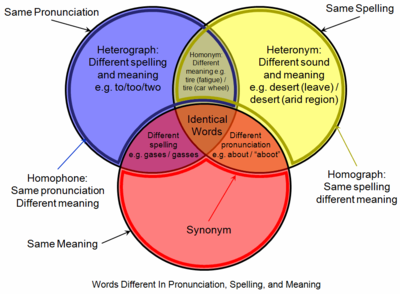The examples and perspective in this article deal primarily with the English language and the Chinese language and do not represent a worldwide view of the subject. (September 2018) |

A homograph (from the Greek: ὁμός, homós 'same' and γράφω, gráphō 'write') is a word that shares the same written form as another word but has a different meaning.[1] However, some dictionaries insist that the words must also be pronounced differently,[2] while the Oxford English Dictionary says that the words should also be of "different origin".[3] In this vein, The Oxford Guide to Practical Lexicography lists various types of homographs, including those in which the words are discriminated by being in a different word class, such as hit, the verb to strike, and hit, the noun a strike.[4]
If, when spoken, the meanings may be distinguished by different pronunciations, the words are also heteronyms. Words with the same writing and pronunciation (i.e. are both homographs and homophones) are considered homonyms. However, in a broader sense the term "homonym" may be applied to words with the same writing or pronunciation. Homograph disambiguation is critically important in speech synthesis, natural language processing and other fields. Identically written different senses of what is judged to be fundamentally the same word are called polysemes; for example, wood (substance) and wood (area covered with trees).
- ^ "One of two or more words that have the same spelling but differ in origin, meaning, and sometimes pronunciation, such as fair (pleasing in appearance) and fair (market) or wind (wĭnd) and wind (wīnd)".
- ^ Homophones and Homographs: An American Dictionary, 4th ed., McFarland, 2006, p. 3.
- ^ Oxford English Dictionary: homograph.
- ^ Atkins, BTS.; Rundell, M., The Oxford Guide to Practical Lexicography, OUP Oxford, 2008, pp. 192 - 193.